Setting the Stage
The 2SLGBTQ+ community is diverse. While L, G, B, T, and Q are usually tied together as a single homogeneous entity, each letter represents a wide range of people of different races, ethnicities, ages, socioeconomic statuses and identities (National LGBT Health Education Centre, 2019). Unfortunately, experiences of stigma and discrimination are a common theme that transcends across the entire 2SLGBTQ+ community. While discrimination exists across the community, the manifestations of oppression and discrimination are not a singular occurrence or experience. One area in which there is a long history of discrimination and lack of awareness is within the health care sector.
The content presented here was created by and in collaboration with members of the 2SLGBTQ+ community. The faculty lead and all collaborators have shared their experiences as members of this diverse community, building a starting point for medical students to consider how they can build an inclusive practice. Because of the incredible diversity within this vast community, not all experiences and perspectives of the 2SLGBTQ+ community are captured here. Specifically, we recognize that there are key components of intersectionality that are not directly addressed in this resource. We know that negative experiences related to gender and sexuality are often compounded for those with intersectional identities such as a black trans man or a disabled Muslim lesbian. For this and other reasons, we welcome adaptations to this resource by those who are committed to moving this work forward (see Using, Citing, Adapting this Module).
Acronym Choice
 There are numerous identities involving gender and sexuality, making it challenging to pick a word or acronym that makes everyone feel included. Our team chose the 2SLGBTQ+ acronym because of the communities this module directly represents. Because we have not specifically built cases around the experiences of asexual or intersex folks (among others), we decided the 2SLGBTQ+ acronym more accurately represented the current focus of the resource.
There are numerous identities involving gender and sexuality, making it challenging to pick a word or acronym that makes everyone feel included. Our team chose the 2SLGBTQ+ acronym because of the communities this module directly represents. Because we have not specifically built cases around the experiences of asexual or intersex folks (among others), we decided the 2SLGBTQ+ acronym more accurately represented the current focus of the resource.
Language and Terminology
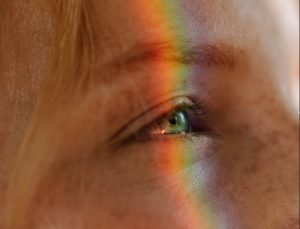
This resource explores terminology, concepts, and word choice and it is important to emphasize that it is critical that health care professionals listen carefully to their patients to understand their individual needs. Every individual is unique. There is no singular experience and in turn, there is no singular term that will work for all individuals. As such, you must listen.
One specific example of this is the term “queer”. This is a term that is embraced by some and rejected by others. Historically the term “queer” was used as an anti-LGBTQ+ term. It has since been deliberately reclaimed and embraced by some members of the 2SLGBTQ+ community as a means of empowerment. However, it is imperative to recognize that the selection to use or not to use that term, is the choice of each LGBTQ+ person. Each person has an individual identity and their own personal experiences- all are valid and all are to be respected.
Listen carefully to patients and the terms that they use for their identity. If you have a question, ask the individual respectfully and ensure that you follow their direction consistently.
Evolving and Changing
As we acknowledge, recognize and learn about the experiences of all people, our understanding and conceptions in this area will evolve. Through this evolution, language and concepts will continue to change. Not only do new words emerge, but our understanding of “old” words will change. We recognize that words are not neutral, and they are a part of our social understanding. We continue to do the work in increasing our understanding and it is imperative that this work be seen as a starting point from which we must evolve.
This resource is not able to provide an encapsulation of all experiences. This resource does not represent the entirety of all healthcare experiences for those who identify as part of the 2SLGBTQ+ community. It is our hope that this resource be used, adapted, revised, and updated to keep the work moving forward.
Pride Flag as a Symbol of Change
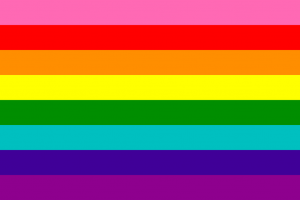 |
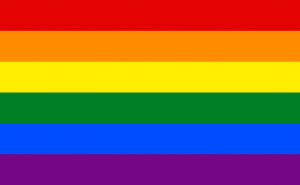 |
One of the most recognizable symbols of the 2SLGBTQ+ community is the rainbow flag. Most commonly we see the six-colour rainbow flag, however, the flag has gone through multiple iterations of development, originally developed with eight colours by Gilbert Baker in 1978. The hot pink was removed because of fabric unavailability, and royal blue replaced both the turquoise and indigo colours.
Progress Pride Flag
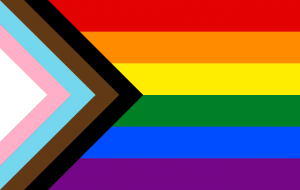
The Flag continues to evolve over time. Those in the 2SLGBTQ+ community who are members of further marginalized groups (e.g., transgender people, people of colour, people with disabilities) experience greater disparities. Increasingly the Progress Pride Flag (image below) is being used to bring focus on diversity, equity and inclusion within the 2SLGBTQ+ community. This flag designed in 2018 brings focus to those who experience further marginalization within the 2SLGBTQ+ community.
Alternative Pride Flags
In 2021, there was an update made to the Progress Pride Flag to better represent the intersex community. The update, in multiple forms, further increases visibility and works towards better inclusivity within the community.
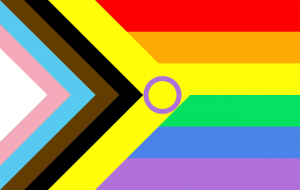 |
 |
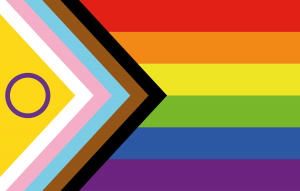 |
Media Attributions
- 2SLGBTQ+
- person with green and black eye © cottonbro is licensed under a CC0 (Creative Commons Zero) license
- Eight-stripe Pride Flag © Gilbert Baker is licensed under a Public Domain license
- Six-stripe Pride Flag © Gilbert Baker is licensed under a Public Domain license
- Progress Pride Flag © Daniel Quasar is licensed under a Public Domain license
- Intersex Inclusive Pride Flag © Katja Anton Cronauer is licensed under a CC0 (Creative Commons Zero) license
- Intersex Inclusive Pride Flag is licensed under a CC BY-SA (Attribution ShareAlike) license
- Intersex Inclusive Pride Flag © Valentino Vecchietti is licensed under a CC0 (Creative Commons Zero) license
2SLGBTQIA / LGBTQ2S+ / LGBTQ+ / LGBTTQQIAAP
Because there are so many identities that involve gender and sexuality, it is often challenging to select a word or acronym that makes everyone feel included.
2S: Two-Spirit (placed first to recognize the historical significance and role of 2-Spirited people)
L: Lesbian
G: Gay
B: Bisexual
T: Transgender
Q: Queer or Questioning
I: Intersex
A: Asexual
P: Pansexual
+ represents the recognition of various identities that may not be represented by current and historical labels
(adjective)
An umbrella term to describe those whose gender identity or expression is different than those typically associated with their assigned sex.
(noun)
a term used to describe a self-identified woman who is attracted to other self-identified women or feminine-aligning people.

